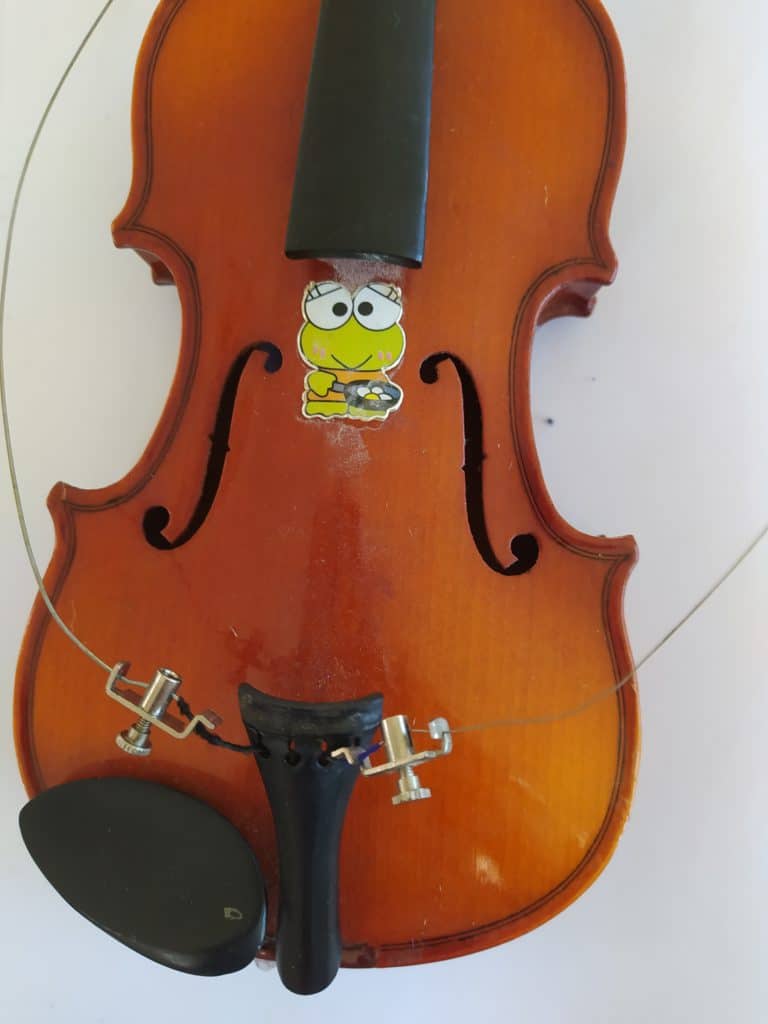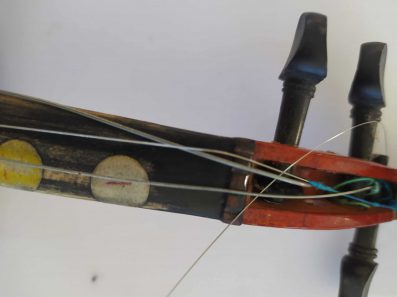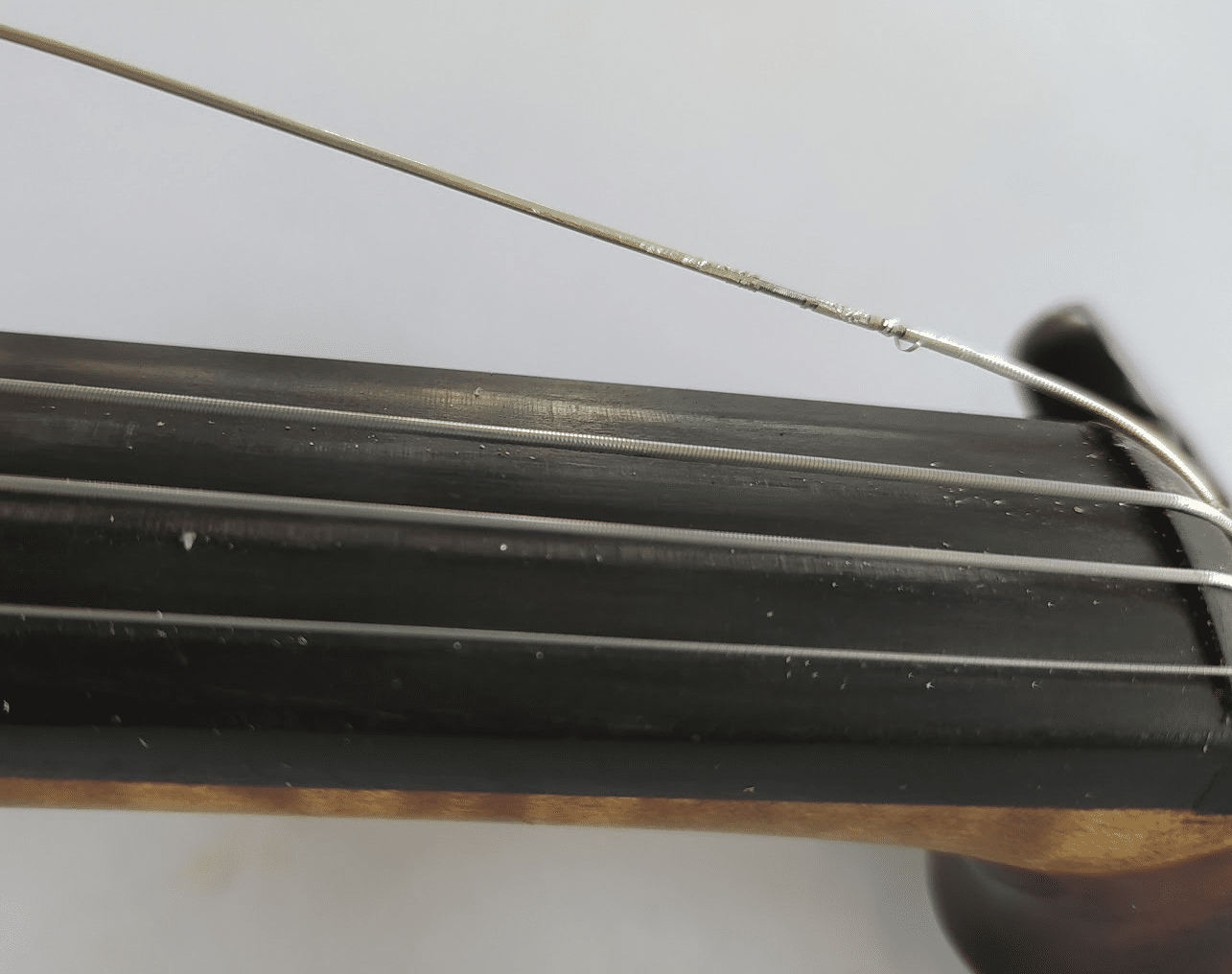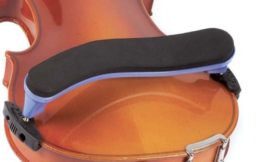So you’ve broken your first string! Don’t despair, this happens all the time and as long as the broken string didn’t pop into your eye or cut your finger, you’re doing well!
In today’s post, I’m going to walk you through the steps on how to change violin strings. Whether you’re replacing just one string or a whole set, this post will give you everything you need to be able to remove your old string and replace it with a brand new one. I’ll also point out some of the common mistakes people make when replacing their strings.
Is My String Actually Broken?
I’ve had students tell me that their strings are broken when really, they’re just loose. The following set of images depict the most common ways your string will look if it is either broken, going to break soon or simply looks broken but just needs to be tightened.
Before You Start:
Before you remove the broken string, you’ll want to have a replacement ready. You’ll also want to read ahead and watch the video to completion so that you don’t bend your new string the incorrect way; it’s often difficult to work with a string that has been twisted or bent out of shape!
There are literally hundreds of different brands of violin string that you can choose from and you’ll find some really good ones here. The strings that I use and recommend for my student are Dominant; I find these to be mellow, forgiving and therefore perfect for student use. If you click here, you can find dominant strings in different sizes and package sizes; this link makes it easy to select the right size string for your instrument
Take the new string out of it’s packet and familiarize yourself with its orientation; you’ll note that some of the more expensive strings include a small piece of plastic tubing wrapped around the higher strings; this is to protect the string from burying it’s way into the wood of your bridge. Be careful not to lose the plastic tubing when you unroll your new string!
Removing The Old String:
It’s important that you remove your string completely and correctly. Don’t just yank the string out from the peg as this may cause damage to the peg or leave a small, difficult to remove part of the string wrapped around the peg.
pull the string gently towards you with one hand while gently unwinding the peg in an anticlockwise direction.
The end of the string may become stuck so be particularly careful not to pull too hard at the final stage; I’ve all too often seen pegs snapped in two from being flung onto a tiled floor in this manner.
Installing The New String:
Before attaching your new string, take a look at the peg and be sure that the hole into which you will insert your string is upwards facing.
Place the ball of the string in its placeholder and gently unwind the string so that it stretches towards the scroll. It is at this stage that many students incorrectly install their string, so be sure that your peg hole is upwards facing as you install your string. You will then be able to rotate the peg in a clockwise direction to tighten it.
All that’s left now is to tune your new string. If you’re replacing the whole set of strings, I’d recommend doing no more than two at a time; wait a couple of days before replacing the remaining strings.
Don't Remove All Your Strings!

There are some fundamental errors that students make when replacing their strings, and removing the lot at once is the biggest!
If you take all your strings out at once, your violin may well fall apart. Once the pressure of your bridge is removed, the sound post (a small cylindrical piece of wood inside the instrument) is likely to dislodge. While I won’t go into details of this here, let’s just say it’s quite a disaster.
If you’re wanting to replace all your strings, do one at a time.
Don't Mix And Match Strings And Pegs!

Make sure that when you replace a string, it goes on it’s correct peg. For example, the A string must always wind around the designated A string peg.
The strings are placed around pegs in such a way that you can tune easily and without disrupting the intonation of other strings. This is another good reason to only change one string at a time!
Don't Use The Wrong Sized Strings!
I was told once by a great salesman at the local music school that it didn’t matter how big the strings were, as long as they were the right string. Needless to say, I never went back to purchase anything from this seller again!
If your string is too big, the sound will warp when you play with more pressure. If your string is too small, there will be insufficient length to attach it to it’s peg.
Don't Turn Your Pegs The Wrong Way!
I guess if you’re the only one ever going to tune your violin, this doesn’t matter all that much. However, I once broke a students brand new E string by loosening it the CORRECT way. Unfortunately, her dad had installed her E string so that a small anticlockwise turn tightened it to the point of snapping.

Congratulations!
Changing your strings is something that you’re going to need to do regularly over the course of your violin journey. Whether it’s a necessary measure due to a broken string or if you’re just wanting to improve your sound quality, these steps will hopefully be helpful to you.
Please do let me know if you have any comments or questions about changing violin strings and remember, if you ever need a hand with anything, leave a comment in the comment section below and I’ll get back to you as soon as I can
Marketa 😉
Founder of myviolinbff.com



Hi Marketa,
I’m not sure if Belinda’s string is broken or just needs to be tuned. I see the pictures but am still not sure. We’re away at the moment so I can’t come past but do you think we could have an earlier lesson day next week because she’s not going to be able to practice with it like this.
Hi Richard,
Unless something drastic has happened since last time I saw you, I don’t think it’s broken; we’ve had some really changing weather over the past few weeks so it’s probably just loose. We can definitely do an earlier day in the week but I’ll sms you about that.
Have a great day
marketa
Hi Marketa,
I’ve been playing violin for a few years but still haven’t been able to change my own strings. I’m going to give it a go after seeing this. Thanks so much!
Hi there and thanks for letting me know!
I’d be interested to know how you go 🙂
Thank you for this useful information about how to change the string of the violin. My son practice violin every day. I think he should interest in do it by himself. You explain it step by step and follow the photo. It makes the explanation easy to read and understanding.
I think everyone can do it after reading your post. I will share it with everyone who learns the violin.
Thx.
Thanks so much for your interest and I’m so glad you’ve found this helpful!
Have a great week ahead
marketa
Hi Marketa,
I came across your site, and as a music lover myself who has dabbled in the violin, and plays guitar, I was interested to see if I would agree with your suggestions and steps, and if I would learn anything new. I’m happy to say yes to both.
I feel like removing all the strings at once is definitely a common pitfall that many stringed instrument players who are just starting out often make. It seems like a good idea if one is coming from other hobbies, but the disaster this can cause on string replacement is definitely one people should avoid. I also liked that you mentioned turning the pegs the wrong way, as I have seen many people do this not just on violins, but other instruments as well. There is a reason the manufacturer wound the original strings they did-for optimal performance and to prevent damage and risk- and therefore one should always see how the other strings are wrapped (another reason not to replace them all at once) and follow their manufacturer’s method.
One thing I didn’t realize that I learned from your article is that the sound post can fall over if you take off all the strings. This is a huge issue indeed, and not only affects the sound of the instrument, but also the structural integrity of it as well.
Thank you so much for sharing this amazing information,
Chri
Hi Chris and thanks so much for taking the time to share your thoughts and experience,
The sound post falling over is really annoying so anything to avoid that! A lot of people who’ve commented on different articles play guitar too and I’m starting to wonder if guitar set up is more similar to violin set up than I’d thought.
Best wishes for a wonderful week ahead!
marketa 😉
Marketa thanks for the pictures of what to look for with a broken string. I thought my daughter’s string was broken and I don’t like messing with it because I am afraid I will make worse. So I took it to the music store that the school’s music director recommends and they fixed it, apparently it was just loose.
Hi Derek,
I hope they didn’t charge you to tighten it! Sometimes students and their parents get ripped off in this way. I’m glad the string is fixed and I encourage you to try changing the string yourself next time using the steps I’ve given.
Have a great day
marketa 😉
Great toturial
I have a friend who actually was looking took replace his violin and also whether he should just replace the strings instead.
I think I will show him how to do this by directing him to this page.
My friend has just learned how to use a voilin and I think that is why his violin is giving him problems.
Hi Thabo and thanks for your message,
Changing the strings could definitely help with the sound quality of the violin. If the violin is so bad that he’s wanting to replace it, you might like to recommend he takes it to a luthier first; sometimes you can have your strings changed, sound post altered etc and the violin actually looks and sounds like a whole new (better) instrument. That being said, it depends how much the instrument is worth in the first place. If it’s a $200 entry level instrument, you’d probably spend more than $200 making it better so probably not worth it.
Anyway, just a thought 😉
Even though I love music and play several musical instruments I have never tried the violin, I play the guitar and the harmonic. I actually am just teaching myself the harmonica, but I have played the guitar since a boy. I was wondering is changing the strings similar on the violin as the guitar, I did get the impression it is very similar when reading your article.
Jeff
Hi Jeff,
I have changed a few guitar strings and yes, it’s quite similar.
I’m finding a lot of guitar players are reading and responding to this article so I’m guessing this post is helpful for them as well!
Best of luck with it 🙂
Hi, Marketa. I’m not much of a violin player but great post.
Question though, what would you recommend I use in terms of the size of the string? Would you say it doesn’t matter and follow the advice of the “great salesman” that said; “as long as it is the right string?” What would your personal advice be?
Thanks. 🙂
Hi Tenyiko,
Definitely DON’T follow the advice of the great salesman. I was being sarcastic and probably should have been more clear. You need the size that corresponds to your violin. So if you’ve got a 3/4 violin, you could probably get away with 1/2 strings but ultimately, you’ll use 3/4 strings. Always buy the matching sized strings. I’ll only put smaller strings if I’m desperate – so, once my daughter had a competition and we’d run out of full sized A strings. I put a 3/4 A string on and it worked but I changed it to full as soon as I had the chance.
Best wishes
🙂
Hi Marketa,
thanks for the great tips. I once took all the strings out and I now know exactly what happened. Something was rattling around in my violin. I could see it was a piece of wood but couldn’t get it out – as you’ve described here, it was the soundpost. Well, now I’ll know not to do that again!
Now I play guitar more so I’m thinking that I can probably change the strings in the same way.
Hi Mike,
yeah, that would have been your sound post; it really sucks if that happens and often you need to take your violin to get professionally fixed. My soundpost once dislodged on a violin I really enjoyed and I couldn’t get the same quality of sound back ever again. I actually ended up using a different violin.
I don’t know much about guitars but I can imagine that the string changing thing is similar.
Thanks for your input and have a great day 🙂
Hi Marketa. Thank you for the article. Do you know if the same technique can be applied to the cello. need to change strings on an old cello I have.
Thanks, Alex
Hi Alex,
Although I don’t play cello personally, I have changed many cello strings using the same method I’ve detailed here. Go ahead and change your strings but do take note of my point not to do them all at once; especially seeing that this is an old cello.
Let me know how you go 🙂
Hi Marketa,
Eli’s D string does seem to be broken (it has the fraying look that you describe but she’s still using it fine. We’re going back to lessons in a couple of weeks so I just feel like it might be worth waiting for the tea her to do it. Do you think the string will be OK for that amount of time?
Hi Benny and thanks for reaching out
Ot depends how much she’s going to practice over the next fortnight. I think you may as well try replacing it yourself. If the string is damaged, it could cut Eli’s finger, or worse, pop off unexpectedly while she’s playing. That’s happened to me before and it only just missed my eye.
Also, why not give it a go yourself? Follow the video and images I’ve provided and I think you’ll find it’s not too much of a difficult task
Beat of luck and happy new year!
Hi, Marketa.
Thanks for sharing the information on how to change strings of violin. I particularly liked the images as I wasn’t sure if I should replace my string or not. It was rough to touch and I thought I’d wait until it broke completely. It seems to me that if I’d waited much longer, it may have snapped at a bad time.
Warm Regards,
Gaurav Gaur
Hi Gaurav and thanks for your response!
Definitely good that you replaced the fraying string. I actually hate the feel of my strings when they get like that; it’s really difficult to slide and I just know it’s going to get worse the longer I leave it.
Do check out my posts on different strings that you could use and best wishes for your violin journey over 2020 and beyond!
Marketa
Definitely going to have to give this tips on changing strings a try. To me this is one of the most important part of using a violin and when I first bought my violin, I was told it is a bit different from changing the strings of a guitar. Now I understand how to do that and fix in a new one as well. Thank you for a well explained tip on changing violin strings.
Hi John and thanks heaps for your feedback!
Great that you’ve found my post useful and I hope you can continue to learn and progress with your violin playing using my videos and posts.
Happy new year and all the best for a prosperous 2020!
marketa
Hi Marketa,
I’ve followed your video and been successful (I think) in changing my A string. Do you have a video about tuning the violin after you change the string? It’s really out. I’m glad you said not to remove more than one string at a time and I’m glad you pointed out the direction of the turn.
Thank you
Parveen
Hi Parveen,
I’m so glad you found my post and accompanying video useful! Good job with changing your A string and I’m so happy that I saved you from installing it in the wrong direction or removing all the strings at once.
I will make a video about tuning shortly; you’re right that the tuning will be very out when you first put a new string on!
Hi Marketa,
I only saw your article when it was too late. I am pretty sure I’ve dislodged my soundpost and I’m also kind of stressing a bit because the bit at the top where the fine tuners are have come undone. Your post would have been better as prevention rather than cure but I’m thinking it’s too late now. What do I do?
Any help is much appreciated!
Feji ben
Hi there, Feji ben and sorry to here of your predicament!
All is not lost but I think you’ll need to take your violin to a luthier, or at least to your teacher to help out. With regard to the sound post, you can get a special tool to move it back into place but it just depends how much your violin is worth. Don’t worry about the tailpiece (the bit where the fine tuners are) too much, that will go back in place when you put the new strings on.
At least you’ll know for next time!
Best of luck with it
Marketa